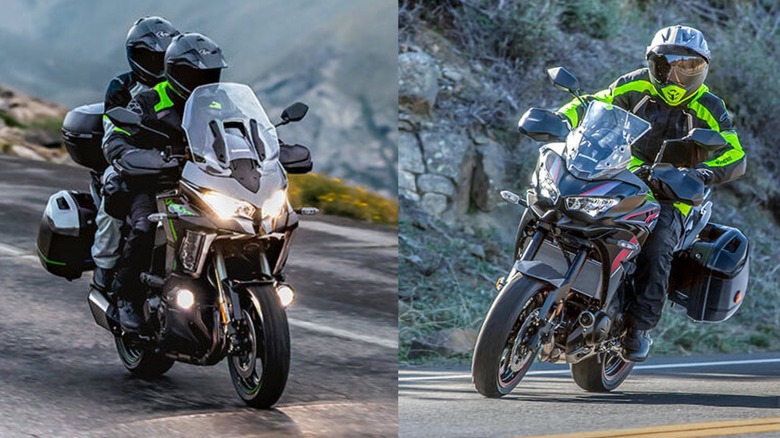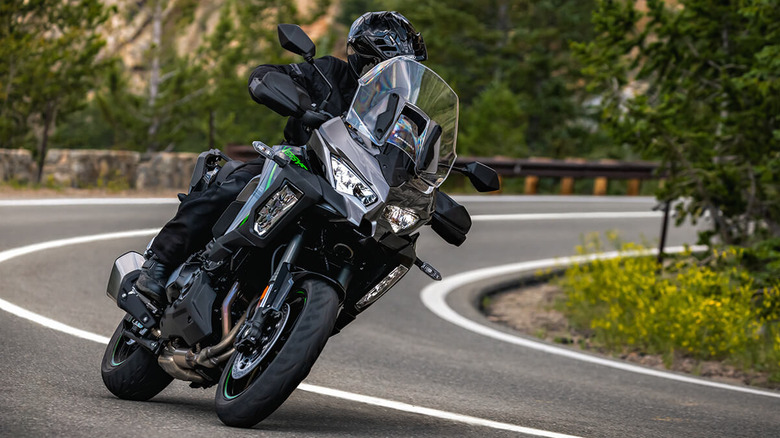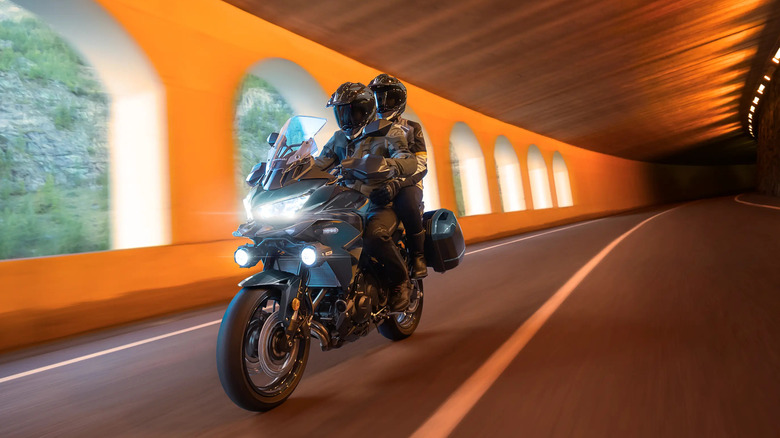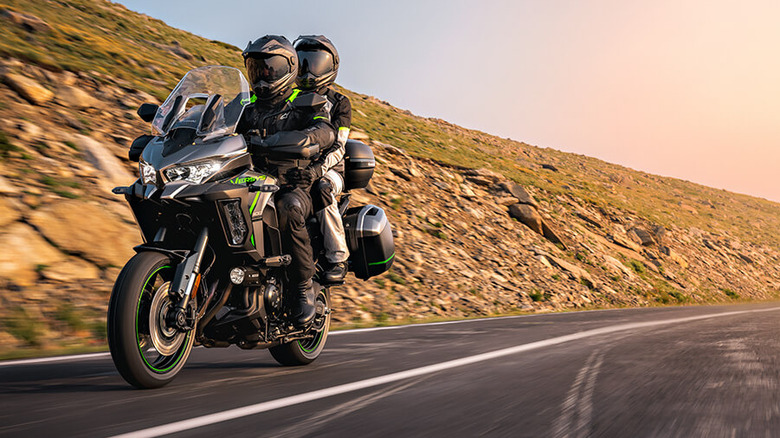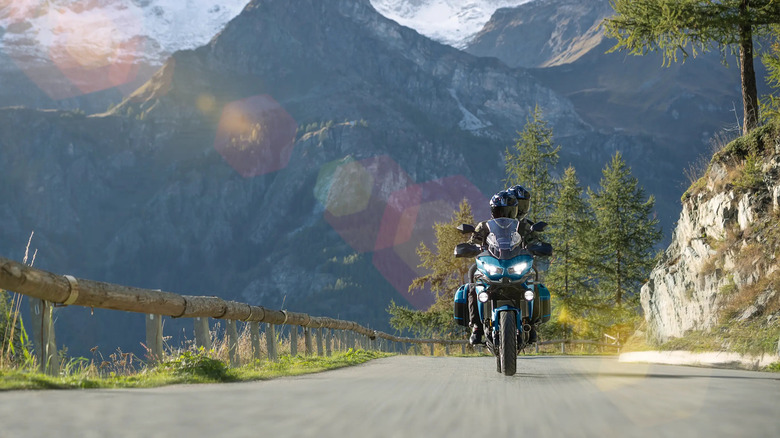Kawasaki Versys 650 Vs 1100 – How Do The Two Touring Bikes Compare?
There's a bike to cover just about every niche these days. Every size, power level, and performance need is met across a wide variety of motorcycles, giving bike shoppers lots of choice no matter what they're looking for. Whether it's a cruiser, sport bike, retro-naked motorcycle, tiny scooter, or big overlanding adventure bike, you can probably get your hands on it somewhere in the new motorcycle market. Kawasaki does a lot to support this trend, with an approach that seems to cover as many bases as possible. This is particularly true in their Adventure Touring category, where multiple options are currently available to riders.
Kawasaki currently offers three Adventure Touring bikes: the Versys-X 300, Versys 650, and Versys 1100. They're all similarly styled with big windscreens, upright riding positions, and long-distance capability, but their sizes and performance levels offer unique virtues. The Versys-X 300 is a bit more dirt-road oriented and geared towards a more entry-level rider. If you're looking for a bit more of an on-road vibe and something that can cross continents, that's where the 650 and 1100 come into play. They can be loaded up with gear, packed for camping, and piloted towards the horizon for your next summer road trip, or round-the-world adventure. But they achieve these goals in different ways and for wildly different prices. So what's different between them? And why does one cost almost $10,000 more than the other?
How much power do they offer?
The Versys 650 is, predictably, the lesser of the two Versys bikes compared here when it comes to power, but it's no slouch. It uses a 649cc parallel-twin engine that's similar to the powerplant used in the naked Z650 and the retro-styled Z650RS. Kawasaki's power ratings put it at 66 horsepower and 44.8 lb-ft of torque, which is totally adequate for a bike of its size. Curb weight is about 483 lbs, but it'll push the Versys over 500 lbs if you add the saddlebags and the hand guards – a worthy bit of added weight for the protection and convenience. The 650 uses a six-speed manual, but there's no quick shifter. It's an omission that lots of manufacturers are making these days on their middleweight bikes, making creature comforts more easily accessible on larger and more expensive bikes.
The Versys 1100 is a real powerhouse compared to the 650. With a 1,099cc inline four-cylinder engine, it puts out 133 hp and 82.5 lb-ft. At 570 lbs, the 1100 is a significantly heavier bike, but the power offered is more than double what the 650 has, so there's no lack of proper thrust. It might not look like a stereotypical sport bike, but the Versys 1100 is properly fast.
How much do they cost?
The new 2026 Versys 650 has an MSRP of $11,084 (including $685 destination fee). The Versys 1100 SE is significantly more expensive. Pricing for the 2026 model hasn't been released yet, but the 2025 model has a price tag of $20,399 (including $840 destination fee). That's a difference of $9,315 between the two bikes. You could buy two Versys 650s, and it would only cost you $1,769 more than buying one of the bigger 1100cc bikes. The difference isn't just power, though. The Versys 1100 has a lot more in the way of creature comforts and modern features.
Just some of the features offered on the 1100 include cruise control, selectable power modes, and cornering lights. Sure, the 650 has some basics like traction control and Bluetooth smartphone connectivity, but it's not feature-packed from the factory. The 1100's brakes are larger and much more powerful too, using 310mm front discs with four-piston calipers up front, and 260mm rear discs with a single-piston caliper. Meanwhile, the 650 uses 300mm front discs with two piston calipers, and 250mm rear discs with single-piston calipers.
Both the 650 and 1100 are available with most of the accessories you'd expect from adventure touring bikes. They can both be had with additional side-case and top-case storage, heated grips, and USB sockets. Their accessories are generally around the same price, so which bike you go with shouldn't change your ability to select the right extras for your riding style.
Differences in size and capability
It might sound strange, but the Versys 1100 actually has a lower seat height, despite being a significantly larger bike. At 33.1 inches, it isn't the lowest Kawasaki seat height, and it's only a tiny bit lower than the 650's 33.3-inch seat height, but for the vertically challenged riders out there, it's worth noting. The 650 has significantly more ground clearance, though. With 6.7 inches of ground clearance, it can clear larger obstacles than the 1100, which offers just 5.9 inches of clearance. Neither of these two bikes is optimized for off-road adventures, but if you wander into the dirt, that extra clearance could help.
From nose to tail, the 650 measures 85.2 inches long and the top of the windshield measures 55.9 inches. The 1100 measures 89.4 inches long, and the top of the windshield is just over 5 feet at 60.2 inches tall. So if you're looking for a bike to squeeze into your small garage, the bigger 1100 might not fit the bill.
Both bikes offer 5.5-gallon fuel tanks, which should mean decent range on the highway, though the larger and more powerful 1100 is likely to be a bit thirstier. Front suspension travel on the 650 measures 5.9 inches, with rear suspension travel measuring 5.7 inches. With the 1100, things are similar via 5.9 inches of travel in both the front and the rear, but additional suspension adjustability settings will help riders dial things in much better on the bigger bike.
What about equipment levels? And what about riding?
The added suspension equipment on the Versys 1100 makes it a bit more versatile than you might expect, adding to comfort and customization. For instance, the 1100 has electronically controlled rebound and compression damping (also known as KECS or Kawasaki Electronic Control Suspension) in both the front and rear, as well as manual spring pre-load adjustability up front and electronically-adjustable preload in the rear. The 650 is a bit lower tech, with manually adjustable preload, but no changes to compression or damping.
I've recently spent a lot of time riding the latest Versys 1100. It's sporty, comfortable, and ready for the kind of cross-country summer road trip where you check off destinations and get lost on winding side roads along the way. The power from the four-cylinder engine is enough for high-speed canyon carving, but it's docile on the highway. The added suspension adjustability really gives it a leg up against the 650 as well. If you want a bike directly from the factory that can do just about anything, it's a strong choice.
Recent reviews of the Versys 650 from outlets like Cycle World praise the bike's do-it-all nature. It's considerably cheaper than the 1100, and it has a lot of the same capability when it comes to comfortable, long-distance adventures. It's not as powerful, but if you're interested in saving a significant bit of money, you should definitely take the 650 for a test ride.
